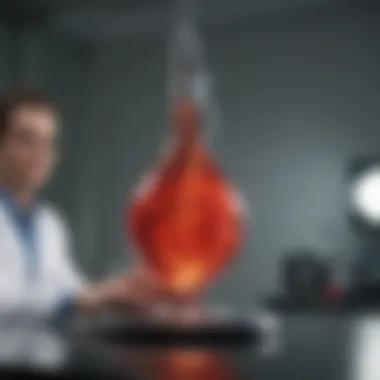Unveiling the Intricacies of Plasma Donation: A Comprehensive Insight


Market Insights
Current Trends and Developments
As the demand for plasma-derived therapies continues to rise globally, driven by increasing awareness and prevalence of plasma-related disorders, the market for plasma donation has experienced a notable uptrend. This upward trajectory can be attributed to advancements in medical technology and the growing preference for plasma-based treatments among healthcare providers. Moreover, the recent emphasis on healthcare sustainability and accessibility has further fueled the expansion of the plasma donation market, creating new opportunities for donors and healthcare institutions alike.
Market Analysis and Predictions
Analyzing the plasma donation market requires a multifaceted approach, considering factors such as supply and demand dynamics, regulatory frameworks, and technological innovations. Market researchers project a steady growth trajectory for the plasma donation sector, with a forecasted increase in donation centers and enhanced donation methodologies. The integration of data-driven strategies and AI-powered solutions is expected to streamline the plasma donation process, ensuring greater efficiency and accuracy in matching donors with patients in need of plasma-based therapies.
Sector-Specific Insights
Within the realm of plasma donation, various sector-specific insights offer valuable perspectives on industry trends and challenges. The emergence of specialized plasma collection facilities, equipped with state-of-the-art technologies for plasma separation and processing, signifies a notable evolution in the sector. Additionally, collaborations between pharmaceutical companies and plasma donation centers have led to the development of innovative therapies, enriching the landscape of plasma-related healthcare solutions. By delving into sector-specific insights, stakeholders can gain a nuanced understanding of the opportunities and complexities inherent in the plasma donation ecosystem.
Introduction
Plasma donation is a critical process that plays a pivotal role in the medical industry. This article aims to provide a comprehensive guide to the experience of donating plasma, shedding light on the essential aspects, benefits, risks, and considerations involved. Understanding the plasma donation process from initial screening to post-donation care is crucial for both donors and recipients.
Overview of Plasma Donation
Definition of Plasma Donation
Exploring the Definition of Plasma Donation unveils the intricate process of extracting plasma from blood. The key characteristic lies in the separation of plasma, a yellowish fluid, from blood cells, which contains vital proteins for various medical treatments. This uniqueness makes plasma donation a popular choice for individuals looking to contribute to medical advancements.
Importance of Plasma in Medical Industry
Highlighting the Importance of Plasma in the Medical Industry emphasizes its significant role in treating various conditions. Plasma is essential for promoting blood circulation, reducing clotting risks, and aiding in medical research. Its versatility in therapies makes it a valuable resource, underscoring its critical role in healthcare.
Purpose of the Article
Informing Readers about Plasma Donation Experience


The key purpose of this article is to inform readers about the intricacies of the plasma donation experience. By delving into the donation process, benefits, risks, and aftercare, readers will gain a deep understanding of what it entails. This article serves as a valuable guide for individuals considering contributing to plasma donation, providing insights to make informed decisions.
Pre-Donation Process
In this section of the article, we delve into the crucial Pre-Donation Process, a fundamental step in the plasma donation journey. Understanding the significance of the pre-donation phase is essential as it sets the foundation for a successful donation experience. By focusing on specific elements such as initial screening and educational materials, we aim to educate readers on the importance of thorough preparation before donating plasma. This segment offers insights into the benefits, considerations, and necessary steps involved in the pre-donation process.
Initial Screening
The initial screening process plays a pivotal role in determining the suitability of potential plasma donors. One key aspect of the initial screening is the Health Questionnaire, which serves as a comprehensive assessment tool to evaluate the donor's medical history, current health status, and potential risk factors. The Health Questionnaire is meticulously designed to gather essential information that enables healthcare professionals to assess the donor's eligibility for plasma donation. Its thoroughness and detailed nature make it a valuable tool in ensuring the safety and well-being of both the donor and the recipient.
Another critical component of the initial screening is the Physical Examination. This step involves a detailed evaluation of the donor's physical health, including vital signs, general health indicators, and any visible health concerns. The Physical Examination enables healthcare providers to assess the donor's overall health and identify any contraindications that may preclude them from donating plasma. By conducting a comprehensive Physical Examination, healthcare professionals can mitigate risks and ensure the donation process is safe and effective.
Educational Materials
Educational materials are essential for providing donors with information and guidance on the plasma donation process. One key aspect of educational materials is the provision of Information on Donation Process. This content offers a step-by-step overview of what donors can expect during the donation process, including detailed explanations of procedures, equipment used, and potential outcomes. By disseminating clear and concise information on the donation process, donors can make informed decisions and feel more confident about their contribution.
Understanding Consent Forms is another vital component of the pre-donation phase. Consent forms outline the donor's rights, responsibilities, and the potential risks associated with plasma donation. By explaining the purpose of consent forms, highlighting key clauses, and ensuring donor comprehension, healthcare providers prioritize transparency and ethical standards. Understanding consent forms empowers donors to make autonomous decisions and reinforces trust in the donation process.
Donation Procedure
The section in this guide serves as a fundamental aspect of understanding the intricate process of donating plasma. It plays a pivotal role in ensuring a successful donation experience while highlighting essential elements, benefits, and considerations that donors need to be aware of. Understanding the donation procedure is crucial as it outlines the steps involved from start to finish, ensuring that donors are informed and prepared for the process ahead. It also sheds light on the importance of following guidelines to guarantee a safe and effective donation, ultimately contributing to the well-being of both donors and recipients.
Plasma Extraction Process
In the broader context of plasma donation, the holds significant relevance. This section delves into two critical components: the and the , each playing a crucial role in the overall donation process. By dissecting these components, donors gain insight into the intricacies of plasma extraction and how their contribution can impact medical treatments and research advancements.
Blood Draw Process
The is a fundamental step in plasma extraction, serving as the initial stage of acquiring plasma from donors. This procedure involves inserting a needle into a vein to collect blood, which is then passed through a centrifuge to separate plasma from other blood components. The precision and efficiency of the are essential as it ensures the purity and quality of the collected plasma. Its importance lies in the accurate extraction of plasma to maximize its usability for various medical purposes.
Separation of Plasma
Following the blood draw, the next crucial phase is the , where the collected blood undergoes centrifugation to isolate the plasma component. This process separates plasma from red blood cells and other elements, resulting in a concentrated plasma solution ready for therapeutic use. The is integral as it guarantees the purity and efficacy of the final plasma product, ensuring that patients receive the necessary components for their treatments without contaminants or impurities.


Duration and Frequency
Understanding the of plasma donation is essential for donors to maintain a sustainable contribution schedule. The time it takes for a typical donation and the recommended intervals between donations play a significant role in structuring a donor's plasma donation routine effectively. By examining these aspects closely, donors can plan their contributions efficiently, optimizing the impact of their donations while prioritizing their own well-being.
Typical Donation Time
The refers to the duration required for a complete plasma extraction session, from the initial setup to the post-donation recovery. This timeframe varies slightly depending on individual factors, but typically, a plasma donation session can last between an hour to an hour and a half. Understanding the allows donors to allocate their time appropriately for each donation session, ensuring a smooth and efficient process.
Recommended Donation Intervals
An equally crucial aspect of plasma donation is the , which dictate how often donors can contribute plasma without compromising their health. These intervals are structured to ensure that donors have sufficient time to replenish the plasma volume, hemoglobin, and protein levels needed for optimal health post-donation. By adhering to these recommended intervals, donors can maintain a sustainable donation schedule that benefits both themselves and the recipients relying on their plasma contributions.
Post-Donation Care
Post-Donation Care is a crucial aspect of the plasma donation process, ensuring that donors recover safely and effectively after their contribution. This section delves into the essential elements, benefits, and considerations regarding post-donation care. It provides donors with the necessary information to navigate the recovery period optimally and minimize any potential risks post-donation.
Recovery Period
- Hydration and Rest: Hydration and Rest play a vital role in post-donation care by promoting quick recovery and replenishing lost fluids. Ensuring adequate hydration levels and ample rest can help donors avoid dizziness, fatigue, and other common side effects post-donation. The unique characteristic of focusing on hydration and rest lies in its simplicity yet fundamental importance in recuperation. Donors are advised to drink plenty of water and engage in light activities, allowing the body to rebuild plasma volume and energy levels gradually.
- Potential Side Effects: Understanding potential side effects is crucial for donors to recognize and address any unusual symptoms after plasma donation. By highlighting common side effects such as bruising, dizziness, or lightheadedness, donors can better prepare for post-donation recovery. This section emphasizes the significance of being vigilant about any unexpected reactions and seeking medical assistance if needed promptly. While side effects are typically mild and temporary, being aware of them helps donors navigate post-donation challenges effectively.
Follow-up Instructions
- Post-Donation Dietary Tips: Post-donation dietary tips are essential for ensuring donors replenish nutrients and support their recovery process effectively. By focusing on a balanced diet rich in iron, protein, and vitamins, donors can maintain their health and avoid potential deficiencies post-donation. This section outlines specific dietary recommendations to promote optimal recovery and support ongoing plasma donation efforts. The unique feature of tailored dietary tips underscores the importance of nutrition in boosting donors' well-being and sustaining their plasma donation journey.
- Monitoring Health: Monitoring health post-donation is crucial for donors to track their well-being and detect any concerning signs promptly. By emphasizing regular health checks and self-assessment techniques, donors can proactively manage their recovery and address any emerging issues timely. This section highlights the benefits of staying vigilant about personal health and outlines practical steps for monitoring vital signs and overall well-being. The unique advantage of proactive health monitoring lies in its ability to empower donors with self-care strategies and promote long-term well-being throughout their plasma donation experience.
Benefits of Plasma Donation
Plasma donation is a critical aspect of healthcare, providing numerous benefits to both donors and recipients. Understanding the significance of plasma donation is essential in appreciating its impact on medical advancements and patient care. By shedding light on the benefits of plasma donation, this article aims to inform readers about the positive outcomes that stem from this selfless act.
Health Benefits
Promoting Blood Circulation


Promoting blood circulation is a vital aspect of plasma donation that directly influences an individual's cardiovascular health. By facilitating the movement of blood throughout the body, promoting blood circulation plays a key role in maintaining overall well-being. This particular aspect of plasma donation enhances the body's ability to transport oxygen and nutrients to various organs and tissues, promoting optimal function and vitality. The unique feature of promoting blood circulation through plasma donation lies in its contribution to reducing the risk of cardiovascular diseases and improving overall cardiovascular fitness. The advantage of this benefit in the context of plasma donation is its potential to positively impact both donors and patients receiving plasma-based therapies, emphasizing the interconnectedness of health outcomes in the medical field.
Reducing Blood Clotting Risks
Another significant health benefit of plasma donation is the reduction of blood clotting risks. By enhancing the fluidity of blood components, plasma donation helps minimize the likelihood of clot formation, which can lead to various complications such as stroke or deep vein thrombosis. Reducing blood clotting risks through plasma donation is a proactive measure to maintain circulatory health and prevent potentially life-threatening conditions. The unique feature of this benefit lies in its ability to mitigate clotting disorders and support optimal blood flow, safeguarding both donors and recipients of plasma-derived products. Incorporating this benefit into the discussion surrounding plasma donation underscores the importance of preventive care and highlights the role of donors in promoting safer healthcare practices.
Social Impact
Contribution to Medical Research
The contribution of plasma donation to medical research is profound, shaping advancements in treatments and therapies across various fields of medicine. Donated plasma serves as a valuable resource for researching and developing innovative healthcare solutions, ranging from new pharmaceuticals to diagnostic tools. The key characteristic of this aspect lies in its capacity to drive scientific progress and enhance medical interventions for diverse patient populations. By supporting medical research through plasma donation, individuals directly contribute to expanding knowledge about diseases and improving healthcare outcomes on a global scale. The unique feature of this contribution is its potential to impact future generations by laying the foundation for groundbreaking medical discoveries. Emphasizing the advantages of this impact in the context of plasma donation underscores the transformative power of each donation in advancing the frontiers of healthcare.
Supporting Patients in Need
The act of supporting patients in need through plasma donation is a testament to human compassion and solidarity within the healthcare community. By providing essential plasma components to individuals undergoing medical treatments, donors play a vital role in enhancing the quality of life for patients facing critical health challenges. The key characteristic of supporting patients in need lies in its ability to directly alleviate suffering and improve patient outcomes through targeted therapy options. This aspect of plasma donation emphasizes the profound impact of generosity and empathy in creating a supportive healthcare environment for individuals in vulnerable situations. The unique feature of this support is its potential to forge enduring connections between donors and patients, fostering a sense of shared purpose and resilience in the face of health adversity. Integrating this perspective into the dialogue on plasma donation highlights the human-centric nature of healthcare and underscores the importance of community engagement in driving positive social change.
Risks and Considerations
In the realm of plasma donation, understanding the risks and considerations is paramount. This section delves into crucial aspects that donors must be aware of before embarking on the donation journey. By shedding light on potential risks and considerations, donors can make informed decisions about their participation. Exploring the nuances of these elements is essential for a comprehensive understanding of plasma donation and its impact on both donors and recipients.
Possible Risks
Bruising or Discomfort
Bruising or discomfort is a common occurrence post-plasma donation. This aspect plays a significant role in donors' post-donation experience and recovery process. The key characteristic of bruising or discomfort lies in its transient nature, typically subsiding within a few days. Despite being a temporary inconvenience, it showcases the physiological response of the body to the donation process. Understanding the nuances of bruising or discomfort provides donors with insights into the body's reaction and aids in managing expectations post-donation.
Allergic Reactions
Allergic reactions stand as another potential risk associated with plasma donation. Highlighting the key characteristic of allergic reactions underscores the importance of pre-donation screenings and donor awareness. While uncommon, allergic reactions can vary in severity, necessitating immediate intervention. The unique feature of allergic reactions lies in their unpredictability, necessitating a vigilant approach from both donors and healthcare providers. Acknowledging the possibility of allergic reactions prepares donors for proactive responses, ensuring a safe donation experience.
Criteria and Eligibility
Age Restrictions
Addressing age restrictions is pivotal in ensuring donor safety and maintaining the quality of donated plasma. The key characteristic of age restrictions lies in aligning donor eligibility with physiological maturity and health standards. Adhering to age restrictions safeguards both donors and recipients, promoting the overall efficacy of the donation process. The unique feature of age restrictions lies in leveraging age-related criteria to optimize donation outcomes while prioritizing donor well-being.
Health Conditions Exclusions
Health conditions exclusions serve as pivotal criteria in donor selection processes. Highlighting the key characteristic of health conditions exclusions emphasizes the significance of donor health status in plasma donation. By excluding individuals with specific health conditions, the donation center upholds quality standards and mitigates potential risks. The unique feature of health conditions exclusions lies in safeguarding both donor and recipient health, underscoring the commitment to responsible donation practices.



